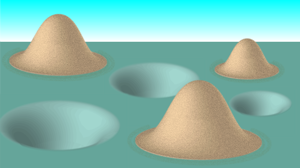Kantorovich Problem
The Kantorovich problem [1] is one of the two essential minimization problems in optimal transport (the other being the Monge problem). It is named after Russian mathematician and Nobel Laureate Leonid Kantorovich.

Introduction
In contrast to the Monge problem, The Kantorovich problem allows a non-empty minimization set, a convex constraint set, and a convex effort functional. The Kantrovich problem admits a dual because it is a linear minimization problem with convex constraints.
Shipping problem
The intuition behind the Kantorovich problem can be given by an explanation of optimizing shipments. Suppose there is a merchant who is attempting to ship items from one place to another. She can hire trucks at some cost for each unit of merchandise which is shipped from point to point . Now the shipper is approached by a mathematician, who claims that prices can be set such that they align with the shipper's financial interests. This would be achieved by setting the price and such that the sum of and is always less than the cost . This may even involve setting negative prices in certain cases. However, it can be shown that the shipper will spend almost as much as she would have if she had opted for the original pricing method.
Kantorovich Optimal Transport Problem
Transport Plans
The Monge problem was about the optimal way to rearrange mass. Note that in the Monge formulation of the optimal transport problem, the mass cannot be split and thus it is mapped . When considering discrete cases, this results in problems when trying to establish maps T such that . Kantorovich made the observation that the mass in question could be split, which makes the problem much easier to model. Allowing the mass to be split results in a relaxation of the problem (e.g. half of the mass from can go to and half can go to , and so on). To model this consider , which denotes the mass transported from x to y. This allows the mass to be moved to multiple places. Also consider and : where the total mass taken from measurable set must be equal to and the total mass taken from measurable set must equal .
The constraints of the problem can be written in the following manner:
for all measurable sets
If we have a that satisfies these constraints, the set of such is referred to as . This is the set of transport plans between and .
Problem Statement
given and
over
Assuming there is a transport map for the Monge problem. Now define . Using this we can see that:
Kantorovich Duality
Since the Kantorovich problem is a linear minimization problem with convex constraints it admits a dual. The astute reader may notice that this is a linear programming problem--Kantorovich is considered to be the founder of linear programming.
- ↑ Villani, Cedric. Topics In Optimal Transportation. American Mathematical Soc., 2003.
- ↑ https://physics.aps.org/articles/v7/77




























